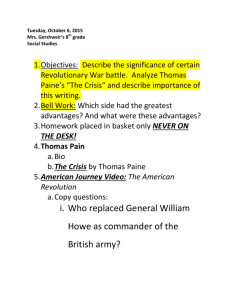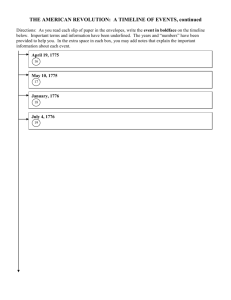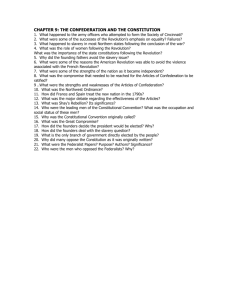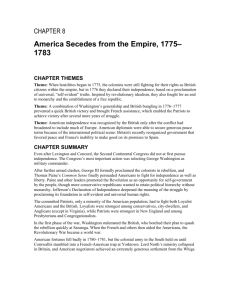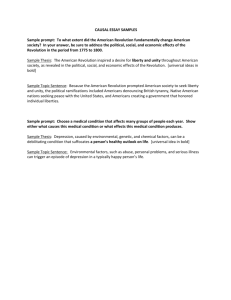Unintended Consequences of the American Revolution
advertisement
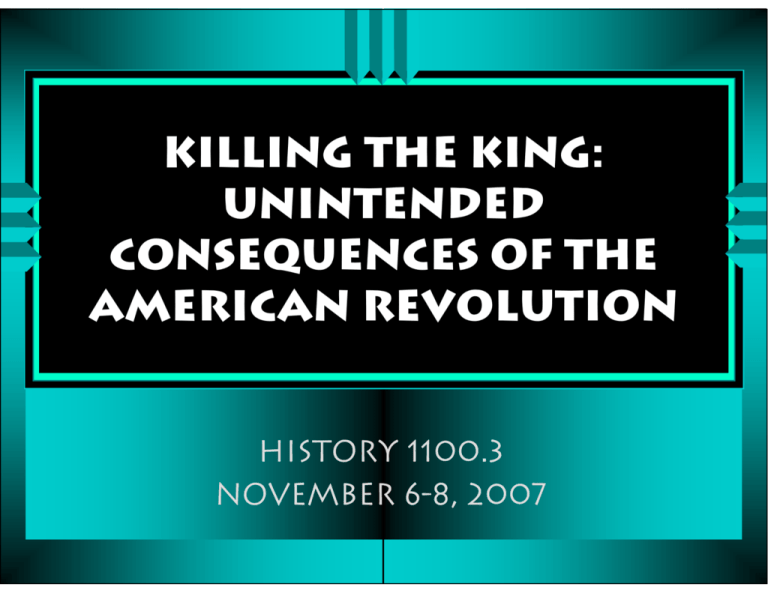
Killing the King: Unintended Consequences of the American Revolution History 1100.3 November 6-8, 2007 X I. Ideological Escalation: From Home Rule to Revolution A. Continuing crises during the 1760s and 1770s caused progressive escalation of American rhetoric and ideas. • -- Patriot elite needed to recruit supporters among the common people, arguing that Americans fought for liberty itself, not just against particular taxes. X B. Implications of the escalation • 1. All coercive authority/sovereignty, all social & political superiority, came under suspicion. • 2. American leaders reconsidered the basis of their rights. "Rights of Englishmen" Americans were once proud of came to seem limited and insufficient. • 3. New basis would be "natural rights": identified by reason, possessed in state of nature, universal, eternal & absolute. II. War, Independence, & Republicanism, 1775-77 X A. With Americans already controlling everything outside Boston, British tried to seize American arms and leaders & war begins, 19 April 1775. • • X 1. Major battles & actions before independence: Lexington & Concord, Ft. Ticonderoga (May 1775), Bunker Hill (June 1775), invasion of Canada (MayDec. 1775), Dorchester Heights (March 1776). 2. Second Continental Congress convened (May 1775-) & began to act like a national government, organizing army, making foreign policy, etc. B. Slow movement toward independence spurs more escalation. • 1. Thomas Paine and Common Sense, 1776, appealed to common people & defined the rebellion’s goals: against monarchy, for political liberty and equality. – Americans knew what they were against, but Paine gave them something to be for: an entirely new form of government (a republic), defined by constitutions. – Paine’s shockingly democratic ideas about how the new governments should be structured: Annually-elected national legislature, w/o an upper house or a permanent executive. • • X 2. Thomas Jefferson’s Declaration of Independence: invoked right of revolution, installed natural rights & Paine’s ideas as founding principles of new nation. 3. As Declaration spread, mobs tore down the statues of the king and real revolution began. C. War Update: The French saved us, not George Washington. • Key battles: Brooklyn Heights (Aug. 76), Trenton (Dec. 76), Saratoga (Oct. 77), occupations of New York City& Philadelphia III. The Revolutionary Transformation of America X A. “The Contagion of Liberty” (from historian Bernard Bailyn) • 1. A process began of making every aspect of American life consistent with Revolution=s stated republican & egalitarian ideals. • 2. Key change was the new absolutism of the American concept of liberty. – Previously, colonists had accepted the reality that almost no one had total liberty. Freedom existed only in degrees. – Examples of partial liberty: indentured servitude, "binding out," and apprenticeship – In a hierarchical society, slavery itself was only a matter of degree, the lowest degree of liberty. – American revolutionaries denounced the idea that there could be any such thing as "partial liberty." • 3. "Outgroups" and reformers developed their own interpretations of Revolutionary ideals, took Revolutionary changes much further than the protesters of the 1760s had ever dreamed. III. The Revolutionary Transformation of America (cont.) X B. The Revolution and the Problem of Slavery • • • 1. Masters into “bosses,” servants into “help,” the decline of servitude in all forms, including apprenticeship. 2. Colonial claims that British meant to make them "slaves" brought out the contradiction between equality/natural rights, and chattel slavery. 3. Blacks petitioned for freedom or otherwise showed that they did not want to be enslaved. – Lord Dunmore's Proclamation (Dec. 1775): Royal governor of VA freed slaves who joined the British. – During war, British freed or confiscated thousands of slaves. Many northern blacks fought on the American side. • 4. Abolition of slavery in the North, led by Pennsylvania (1780) & Massachusetts (1783) – New England: slavery economically was insignificant, abolition was quick – Middle States: slavery was relatively important, so abolition was slower to come, & gradual. • 5. Growth of an independent free black community in the North, especially Philadelphia. – Example of Richard Allen, Absalom Jones, & the AME Church. • 6. Huge secondary consequence: Revolution created the sectional difference that brought the Civil War. III. The Revolutionary Transformation of America (conT.) X C. The Revolution Against Patriarchal Authority • • • • Judith Sargent Murray 1. Decline of deference in daily social life and styles. 2. “Remember the Ladies”: Women’s revolutionary experience, rise of companionate marriage. 3. New attitudes regarding women: “Republican motherhood,” early feminism and the revolution in female education. 4. The children of the Revolution rebel: world-renowned as least obedient – Parents lost much of their economic ability to control behavior & choices of youth. – Post-revolutionary epidemic of premarital pregnancy • "Bundling" was apparently not enough. [Sketch of bundling bag.] – Rise of relatively unsupervised social activities for young people, bringing first youth culture & peer groups. – Collapse of discipline, riots on college campuses III. The Revolutionary Transformation of America (conT.) X D. The Revolutionary Transformation of Criminal Justice • • • • X E. The Attack on Political Authority: The Democratic Revolution in Politics • • • • • X 1. Extensive rights for the accused was a central part of controversy with British. Mason’s Virginia Declaration of Rights (1776) set the list later included in Bill of Rights: speedy trial by jury; knowledge of charges and accuser; searches only by specific warrant; no detention without charge, excessive bail, or cruel & unusual punishment. 2. Laws & procedures revised, by Jefferson and others, according to principles of Enlightenment theorist Beccaria. 3. End of judicial torture, corporal punishment (whipping), mutilation, public humiliation as part of criminal justice system. 4. Restriction of death penalty to only the most serious crimes: treason, premeditated or aggravated murder & arson. Prisons built instead. 1. Written state constitutions (world’s first) put tight, publicly-stated limits on government authority. Emergence of “constitutions” as we now define them. 2. Typical features of early state constitutions: weak governors, weak judiciaries, broad suffrage. Most radical was the Pennsylvania Constitution of 1776, inspired by Paine. 3. Confiscation of Loyalist property. 4. Democratic state politics: new men in power, laws protecting debtors, localism, little cooperation with Congress. 5. Common people (including soldiers) rebelled, rioted, and mutinied when they thought their rights were violated. F. "Disestablishment" of the churches in the South and the Middle States: Jefferson’s Bill for Establishing Religious Freedom (1779) • Increased sectional differences – New England does not disestablish its churches. IV. A National Government Without Sovereignty: The Articles of Confederation X X A. Confederation represented the states, not people at large. B. Dismembering the King: National government a major victim of Revolutionary ideas • 1.People wanted very direct representation, feared/hated authority. Suspicion/fear of coercive authority prevented giving any real power to the US government. – Underlying problem: only states were representative republican governments that could legitimately have powers like taxation. • • X C. Economic crisis of the Confederation • • • X 2. Confusion: Despite state sovereignty, Congress had many sovereign-like powers. 3. Practical problems with the Articles: Congress elected by states, each state had one vote; Confederation had no taxing power or ability to compel states; there was a “President” but no executive; unanimous vote needed to amend. 1. Confederation had to pay for war by requisitioning money from the states or printing or borrowing it. 2. New democracy in the states made taxation difficult. 3. States’ failure to pay Congress or manage their own finances correctly led to hyperinflation & bankruptcy. D. International Weakness of the Confederation • • • 1. Could not force states to comply with Treaty of Paris (1783) ending war. 2. British kept their western forts open and restricted American commerce. 3. Spanish closed New Orleans and the Mississippi River (1784). Lexington and Concord, Apr. 1775 Thomas Paine & Common Sense X X X Paine's background: uneducated, working-class perspective; a trouble-making staymaker & tax collector who had recently fled political repression in Great Britain Dr. Benjamin Rush, a radical afraid to jeopardize his practice, suggested that Paine, a Philadelphia bookstore clerk, write a pamphlet urging common people to support independence. Key quotations: • • • • • “Everything that is right or natural pleads for separation . . . The blood of the slain, the weeping voice of nature cries, TIS TIME TO PART.” "The Royal Brute" had "sunk himself below the rank of animals, and contemptibly crawls through the world like a worm." Attacked the patriarchal theory of monarchy: King only “the pretended Father of his people” In Britain, the “King was the law.” In America, “the law was King.” “A new era for politics is struck; and a new method of thinking hath arisen . . . We have every opportunity . . . to form the noblest, purest constitution on the face of the earth. We have it in our power to begin the world again.”
